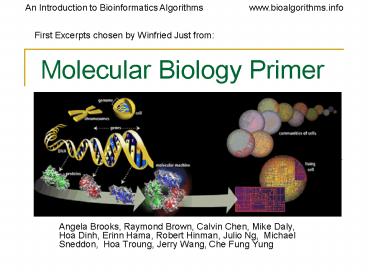Molecular Biology Primer PowerPoint PPT Presentation
1 / 18
Title: Molecular Biology Primer
1
Molecular Biology Primer
First Excerpts chosen by Winfried Just from
- Angela Brooks, Raymond Brown, Calvin Chen, Mike
Daly, Hoa Dinh, Erinn Hama, Robert Hinman, Julio
Ng, Michael Sneddon, Hoa Troung, Jerry Wang,
Che Fung Yung
2
Section1 What is Life made of?
3
Outline For Section 1
- All living things are made of Cells
- Prokaryote, Eukaryote
- What is Inside the cell From DNA, to RNA, to
Proteins
4
Cells
- Fundamental working units of every living system.
- Every organism is composed of one of two
- radically different types of cells
- prokaryotic cells or
- eukaryotic cells.
- Prokaryotes and Eukaryotes are descended from
the same primitive cell. - All extant prokaryotic and eukaryotic cells are
the result of a total of 3.5 billion years of
evolution.
5
Cells
- Chemical composition-by weight
- 70 water
- 7 small molecules
- salts
- Lipids
- amino acids
- nucleotides
- 23 macromolecules
- Proteins
- Polysaccharides
- lipids
6
2 types of cells Prokaryotes v.s.Eukaryotes
7
Prokaryotes and Eukaryotes
- According to the most recent evidence, there are
three main branches to the tree of life. - Prokaryotes include Archaea (ancient ones) and
bacteria. - Eukaryotes are kingdom Eukarya and includes
plants, animals, fungi and certain algae.
8
Prokaryotes and Eukaryotes, continued
9
Prokaryotes v.s. EukaryotesStructural differences
- Prokaryotes
- Eubacterial (blue green algae)
- and archaebacteria
- only one type of membrane--
- plasma membrane forms
- the boundary of the cell proper
- The smallest cells known are bacteria
- Ecoli cell
- 3x106 protein molecules
- 1000-2000 polypeptide species.
- Eukaryotes
- plants, animals, Protista, and fungi
- complex systems of internal membranes forms
- organelle and compartments
- The volume of the cell is several hundred times
larger - Hela cell
- 5x109 protein molecules
- 5000-10,000 polypeptide species
10
Prokaryotic and Eukaryotic CellsChromosomal
differences
- Prokaryotes
- The genome of E.coli contains amount of t 4X106
base pairs - gt 90 of DNA encode protein
- Lacks a membrane-bound nucleus.
- Circular DNA and supercoiled
- domain
- Histones are unknown
- Eukaryotes
- The genome of yeast cells contains
- 1.35x107 base pairs
- A small fraction of the total DNA encodes
protein. - Many repeats of non-coding sequences
- All chromosomes are contained in a membrane bound
nucleus - DNA is divided between two or more chromosomes
- A set of five histones
- DNA packaging and gene expression regulation
11
Signaling Pathways Control Gene Activity
- Instead of having brains, cells make decision
through complex networks of chemical reactions,
called pathways - Synthesize new materials
- Break other materials down for spare parts
- Signal to eat or die
12
Cells Information and Machinery
- Cells store all information to replicate itself
- Human genome is around 3 billions base pair long
- Almost every cell in human body contains same set
of genes - But not all genes are used or expressed by those
cells - Machinery
- Collect and manufacture components
- Carry out replication
- Kick-start its new offspring
- (A cell is like a car factory)
13
Overview of organizations of life
- Nucleus library
- Chromosomes bookshelves
- Genes books
- Almost every cell in an organism contains the
same libraries and the same sets of books. - Books represent all the information (DNA) that
every cell in the body needs so it can grow and
carry out its various functions.
14
Some Terminology
- Genome an organisms genetic material
- Gene a discrete units of hereditary information
located on the chromosomes and consisting of DNA. - Genotype The genetic makeup of an organism
- Phenotype the physical expressed traits of an
organism - Nucleic acid Biological molecules(RNA and DNA)
that allow organisms to reproduce
15
All Life depends on 3 critical molecules
- DNAs
- Hold information on how cell works
- RNAs
- Act to transfer short pieces of information to
different parts of cell - Provide templates to synthesize into protein
- Proteins
- Form enzymes that send signals to other cells and
regulate gene activity - Form bodys major components (e.g. hair, skin,
etc.)
16
DNA, RNA, and the Flow of Information
Replication
Translation
Transcription
17
Overview of DNA to RNA to Protein
- A gene is expressed in two steps
- Transcription RNA synthesis
- Translation Protein synthesis
18
Proteins Workhorses of the Cell
- 20 different amino acids
- different chemical properties cause the protein
chains to fold up into specific three-dimensional
structures that define their particular functions
in the cell. - Proteins do all essential work for the cell
- build cellular structures
- digest nutrients
- execute metabolic functions
- Mediate information flow within a cell and among
cellular communities. - Proteins work together with other proteins or
nucleic acids as "molecular machines" - structures that fit together and function in
highly specific, lock-and-key ways.

